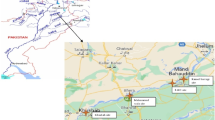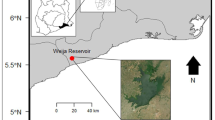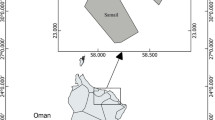Abstract
The aim of the present study was to describe the accumulation of trace metals in the liver, kidney, gills, muscles, and skin of four edible fish species (Tor putitora, Cirrhinus mrigala, Labeo calbasu, and Channa punctatus) of Rawal Lake Reservoir, Pakistan. The fish samples were collected in the pre-monsoon (May 2008) and post-monsoon (October 2007) seasons and were analyzed for heavy metals by using an atomic absorption spectrometer. Kidney and liver showed relatively high concentrations of heavy metals. The accumulation of metals in the different organs of the fish (skin, muscles, and gills) in post-monsoon was higher than in pre-monsoon. In pre-monsoon, the metals followed the trend Zn > Pb > Fe > Cr > Ni > Mn > Co > Cu > Cd > Li, while in the post-monsoon season, the trend was Fe > Pb > Cr > Ni > Zn > Cu > Co > Mn > Cd > Li. The concentrations of Ni, Cr, and Pb in the muscle of all fish species were higher than the WHO guideline values of heavy metals in fishes for human consumption except in T. putitora. Cu level was nearly equal to the WHO maximum levels in C. mrigala and L. calbasu, while it was lower in T. putitora and C. punctatus. It is strongly advocated that risk assessment studies should be conducted and there is an urgent need for water quality restoration and management of Rawal Lake Reservoir.



Similar content being viewed by others
References
Ahmad MGT, Afzal H (2001) Concentration levels of heavy and trace metals in the fish and relevant water from Rawal and Mangla Lakes. J Biol Sci 1:414–416
Alam MGM, Tanaka A, Allinson G, Laurenson LJB, Stagnitti F, Snow ET (2002) A comparison of trace element concentrations in cultured and wild carp (Cyprinus carpio) of Lake Kasumigaura, Japan. Ecotoxicol Environ Saf 53(3):348–354. doi:10.1016/s0147-6513(02)00012-x
Ashraf W (2005) Accumulation of heavy metals in kidney and heart tissues of Epinephelus microdon fish from the Arabian Gulf. Environ Monit Assess 101(1):311–316
Bauer SB, Ralph SC (2001) Strengthening the use of aquatic habitat indicators in Clean Water Act programs. Fisheries 26(6):14–25
Burger J, Gaines KF, Boring CS, Stephens WL, Snodgrass J, Dixon C, McMahon M, Shukla S, Shukla T, Gochfeld M (2002) Metal levels in fish from the Savannah River: potential hazards to fish and other receptors. Environ Res 89(1):85–97
Burger J, Gochfeld M (2006) Mercury in fish available in supermarkets in Illinois: are there regional differences. Sci Total Environ 367(2):1010–1016
Canli M, Atli G (2003) The relationships between heavy metal (Cd, Cr, Cu, Fe, Pb, Zn) levels and the size of six Mediterranean fish species. Environ Pollut 121(1):129–136
Canli M, Ay O, Kalay M (1998) Levels of Heavy Metals (Cd. Pb, Cu, Cr and Ni) in tissue of Cyprinus carpio, Barbus capito and Chondrostoma regium from the Seyhan River, Turkey. Turkish journal of zoology 22:149–158
Canli M, Furness R (1993) Toxicity of heavy metals dissolved in sea water and influences of sex and size on metal accumulation and tissue distribution in the Norway lobster Nephrops norvegicus. Mar Environ Res 36(4):217–236
Chan KM (1995) Metallothionein: potential biomarker for monitoring heavy metal pollution in fish around Hong Kong. Mar Pollut Bull 31(4):411–415
Chandra Sekhar K, Chary N, Kamala C, Suman Raj D, Sreenivasa Rao A (2004) Fractionation studies and bioaccumulation of sediment-bound heavy metals in Kolleru lake by edible fish. Environ Int 29(7):1001–1008
Chouba L, Kraiem M, Njimi W, Tissaoui C, Thompson J, Flower R (2007) Seasonal variation of heavy metals (Cd, Pb and Hg) in sediments and in mullet, Mugil cephalus (Mugilidae), from the Ghar El Melh Lagoon (Tunisia). Transitional Waters Bulletin 1(4):45–52
Dallinger R, Kautzky H (1985) The importance of contaminated food for the uptake of heavy metals by rainbow trout (Salmo gairdneri): a field study. Oecologia 67(1):82–89
Fernandes C, Fontainhas-Fernandes A, Cabral D, Salgado MA (2008) Heavy metals in water, sediment and tissues of Liza saliens from Esmoriz–Paramos lagoon, Portugal. Environ Monit Assess 136(1):267–275
Forstner U (1981) Metal pollution assessment from sediment analysis. In: Forstner U, Wittmann GTW (eds) Metal pollution in the aquatic environment. Springer, Berlin, p 486
Franklin A, Jones J (1993) Monitoring and surveillance of non-radioactive contaminants in the aquatic environment and activities regulating the disposal of wastes at sea, 1991
Hashmi MZ, Malik RN, Shahbaz M (2013) Heavy metals in eggshells of cattle egret (Bubulcus ibis) and little egret (Egretta garzetta) from the Punjab province, Pakistan. Ecotoxicol Environ Saf 89:158–165
Karuppasamy R (2004) Evaluation of Hg concentration in the tissue of fish Channa punctatus (Bloch.) in relation to short and long-term exposure to phenyl mercuric acetate. J Plat Jubilee AU 40:197–204
Koss G, Schüler E, Arndt B, Seidel J, Seubert S, Seubert A (1986) A comparative toxicological study on pike (Esox lucius L.) from the river Rhine and river Lahn. Aquat Toxicol 8(1):1–9
Kotzé PJ (1997) Aspects of water quality, metal contamination of sediment and fish in the Olifants River, Mpumalanga. M.Sc. Thesis, Rand Afrikaans University
MacFarlane G, Burchett M (2000) Cellular distribution of copper, lead and zinc in the grey mangrove, Avicennia marina (Forsk.) Vierh. Aquat Bot 68(1):45–59
Mallatt J (1985) Fish gill structural changes induced by toxicants and other irritants: a statistical review. Can J Fish Aquat Sci 42(4):630–648
Marcovecchio JE (2004) The use of Micropogonias furnieri and Mugil liza as bioindicators of heavy metals pollution in La Plata river estuary, Argentina. Sci Total Environ 323(1–3):219–226
Martin M, Coughtrey P (1982) Biological monitoring of heavy metal pollution: land and air. Applied Science Publishers, London
Mendil D, Uluözlü ÖD, Hasdemir E, Tüzen M, Sari H, Suiçmez M (2005) Determination of trace metal levels in seven fish species in lakes in Tokat, Turkey. Food Chem 90(1–2):175–179
Metelev VV, Kanaev A, Dzasokhova N (1983) Water toxicology. Amerind Publishing Co., New Delhi
Mormede S, Davies I (2001) Heavy metal concentrations in commercial deep-sea fish from the Rockall Trough. Cont Shelf Res 21(8):899–916
Nauen CE (1983) Compilation of legal limits for hazardous substances in fish and fishery products. FAO Fish Circ 764
Nordberg G (2007) Handbook on the toxicology of metals. Academic, New York
Obasohan EE (2007) Heavy metals concentrations in the offal, gill, muscle and liver of a freshwater mudfish (Parachanna obscura) from Ogba River, Benin city, Nigeria. Afr J Biotechnol 6(22):2620–2627
Ohe T, Watanabe T, Wakabayashi K (2004) Mutagens in surface waters: a review. Mutat Res 567(2):109–149
Oronsaye J (1989) Histological changes in the kidneys and gills of the stickleback, Gasterosteus aculeatus L, exposed to dissolved cadmium in hard water. Ecotoxicol Environ Saf 17(3):279–290
Papagiannis I, Kagalou I, Leonardos J, Petridis D, Kalfakakou V (2004) Copper and zinc in four freshwater fish species from Lake Pamvotis (Greece). Environ Int 30(3):357–362
Plette ACC, Nederlof MM, Temminghoff EJM, Van Riemsdijk WH (1999) Bioavailability of heavy metals in terrestrial and aquatic systems: a quantitative approach. Environ Toxicol Chem 18(9):1882–1890
Qadir A, Malik RN, Husain SZ (2008) Spatio-temporal variations in water quality of Nullah Aik-tributary of the river Chenab, Pakistan. Environ Monit Assess 140(1):43–59
Strydom C, Robinson C, Pretorius E, Whitcutt J, Marx J, Bornman MS (2007) The effect of selected metals on the central metabolic pathways in biology: a review. Water SA 32(4):543–554
Tapia J, Vargas-Chacoff L, Bertrán C, Peña-Cortés F, Hauenstein E, Schlatter R, Jiménez C, Tapia C (2012) Heavy metals in the liver and muscle of Micropogonias manni fish from Budi Lake, Araucania Region, Chile: potential risk for humans. Environ Monit Assess 184(5):3141–3151
Uysal K, Emre Y, Köse E (2008) The determination of heavy metal accumulation ratios in muscle, skin and gills of some migratory fish species by inductively coupled plasma-optical emission spectrometry (ICP-OES) in Beymelek Lagoon (Antalya/Turkey). Microchem J 90(1):67–70
Vernhet L, Séité MP, Allain N, Guillouzo A, Fardel O (2001) Arsenic induces expression of the multidrug resistance-associated protein 2 (MRP2) gene in primary rat and human hepatocytes. J Pharmacol Exp Ther 298(1):234–239
Widianarko B, Van Gestel C, Verweij R, Van Straalen N (2000) Associations between trace metals in sediment, water, and guppy, Poecilia reticulata (Peters), from urban streams of Semarang, Indonesia. Ecotoxicol Environ Saf 46(1):101–107
Yang R, Yao T, Xu B, Jiang G, Xin X (2007) Accumulation features of organochlorine pesticides and heavy metals in fish from high mountain lakes and Lhasa River in the Tibetan Plateau. Environ Int 33(2):151–156
Yilmaz AB (2003) Levels of heavy metals (Fe, Cu, Ni, Cr, Pb, and Zn) in tissue of Mugil cephalus and Trachurus mediterraneus from Iskenderun Bay, Turkey. Environ Res 92(3):277–281
Acknowledgments
This research work is conducted under the research project “Ecological Impact Assessment of Selected Wetlands of Pakistan” (project no. 02-828/RND/07), which was funded by the Higher Education Commission. The authors are grateful to the Pakistan Wetlands Programme for providing transport to Rawal Lake Reservoir for the fish sampling.
Author information
Authors and Affiliations
Corresponding author
Additional information
Responsible editor: Vera Slaveykova
Rights and permissions
About this article
Cite this article
Malik, R.N., Hashmi, M.Z. & Huma, Y. Heavy metal accumulation in edible fish species from Rawal Lake Reservoir, Pakistan. Environ Sci Pollut Res 21, 1188–1196 (2014). https://doi.org/10.1007/s11356-013-1992-3
Received:
Accepted:
Published:
Issue Date:
DOI: https://doi.org/10.1007/s11356-013-1992-3




